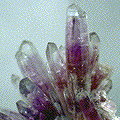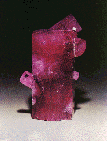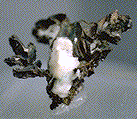PEARL is often considered a gemstone, although it is not a mineral. Rather, pearl is a composite of the mineral Aragonite (Calcium Carbonate) and the organic compound conchiolin (a protein). The combination is called nacre, or mother-of-pearl. In some cases, there is an admixture of the mineral calcite (another mineral composed of Calcium Carbonate). In pearl oysters and freshwater pearl mussels, nacre forms the inner lining of the shell. In most other molluscs the shell has an appearance more like porcelain, and lacks the luster and iridescence of mother-of-pearl. A pearl is formed inside these molluscs when minute hexagonal crystals of aragonite and conchiolin (as a binder) are deposited over an irritant. As a composite, it is tougher than the aragonite from which it's formed, and the layered nature of the structure contributes to the luster of the pearl. An ideal pearl is spherical, but other shapes are common. A pearl may even become cemented against the inner wall of the shell, and eventually become a blister pearl. Most pearls are "cultured", meaning the oysters (or mussels) have been opened and a "seed" inserted into the flesh of the oyster. The oyster then secretes nacre over the seed, eventually covering it with mother-of-pearl and a pearl is formed. Note that a natural pearl of significant size takes many years to form, as only a fraction of a millimeter of nacre is deposited each year. But for a cultured pearl, a bead is inserted as a seed (typically composed of shell), and the oyster may be harvested (and the pearl removed) in as little as six months, although for higher quality pearls (a thicker layer of mother-of-pearl) the harvest may not be done for several years. Different species have different secretion rates of nacre, so the minimum time varies widely. At one time, pearls were very rare and expensive, because more than a thousand oysters might be harvested to find a single pearl, and that one may have been small or misshapen. However, raising oysters or freshwater pearl mussels is relatively easy, and the process of inserting the "seeds" has been perfected, such that cultured pearls are now harvested by the ton. Still, only a fraction of the harvest will be of high-quality pearls. Note that imitation pearls are common. These may be made of ceramics, plastics, or other materials. The simplest test (which is not, unfortunately, infallible) is the "tooth" test. Rub the pearl against the front of your tooth. If it feels smooth, it is a fake pearl. If it feels slightly gritty, it may be genuine (or a really well-made fake). There is no easy test for natural versus cultured pearls, other than to break it or slice it to see if the interior is all concentric layers (as in a natural pearl) or if the center (the bulk of the pearl) is ordinary shell material without layering. Pearl is a Birthstone for June, and for the astrological signs of Scorpio and Cancer. It is the traditional gift for a 30th anniversary (reflecting its historical high value), although in the modern lists Pearls are to be given for the twelfth anniversary. Pearls are associated with the values of modesty, purity, beauty, and happiness. Amethyst Galleries sells natural mineral specimens, including precious metals and gemstones, but not (at present) Pearls. For Pearls or Pearl Jewelry, please visit our affiliates. |






















